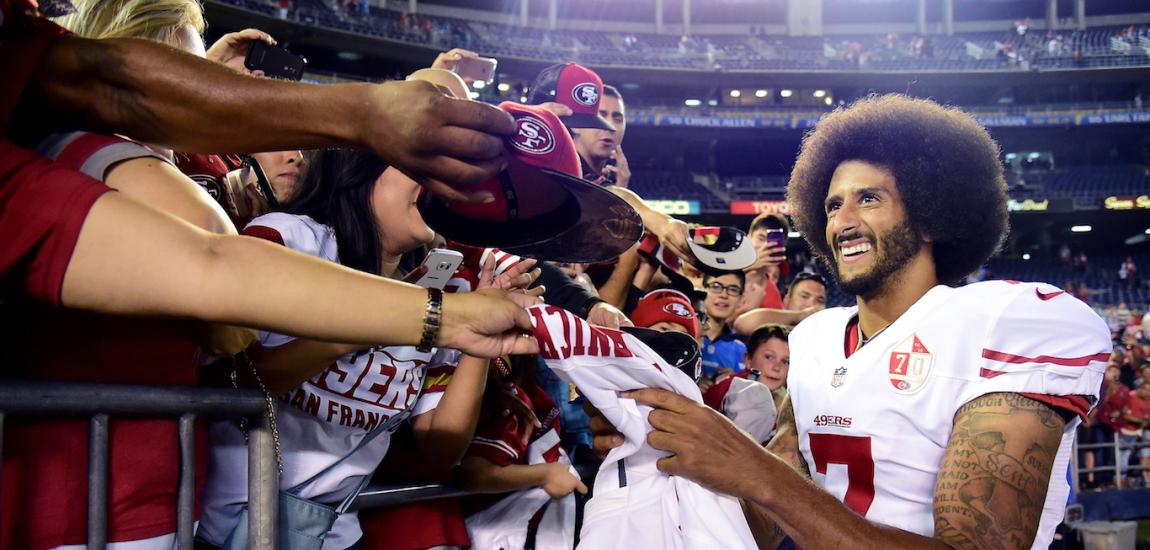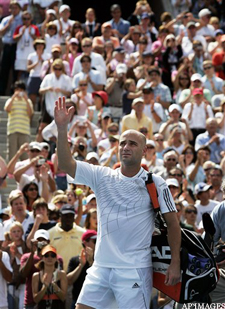
Andre Agassi is in a temporary tent in Juan Pablo Duarte Square in New York City. Outside, a few hundred people await Agassi on a makeshift court set up by Nike along Canal Street. Agassi's associates prep him on what he needs to wear, when he needs to be on the court and what he is going to do.
For the eight-time Grand Slam champion, this chaos is nothing out of the ordinary. If anything, this Friday before the U.S. Open is tame compared to others.
"This was one of the great times in my life coming here once a year," Agassi says. "You never knew what was going to happen and if magic happened, it was indelibly imprinted. There were some incredible years here–multiple incredible years. Ending here felt right."
Despite the anticipation of the Manhattan crowd and the bustling of Nike officials around him, Agassi, 44, is unfazed. There is clear comfort talking about the U.S. Open, as if Agassi is making conversation at the dining room table.
It is almost eight years to the day Agassi played his final professional match, a third-round loss on Sept. 3, 2006, at the hands of then-25-year-old German Benjamin Becker. Agassi missed the first two Grand Slams that season with multiple injuries and hobbled into Flushing Meadows for one last lunge. The New York crowd willed the 36-year-old into the third round by way of an epic five-set win over eighth-seeded Marcos Baghdatis.
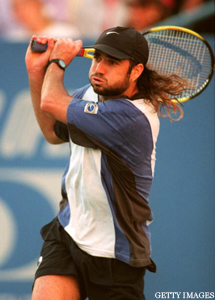
In 2014, Agassi comes into town with a different mindset. He raises his son and daughter, Jaden and Jaz, in his hometown of Las Vegas, with wife and 22-time Grand Slam champion Steffi Graf. Unlike many athletes who have trouble embracing their post-playing days, Agassi is comfortable as a retiree.
"While there's that energy [in New York}, there's the feeling of being here now not worried about how I feel," Agassi says. "Waking up, seeing the weather coming in a bit humid and anticipating the Open and some great tennis but not having to be at my best, I really like where I'm at. I like being on the sidelines just watching and reflecting."
As outlined in his 2009 autobiography, Open, Agassi's life has been full of twists and turns off the court. His parents, Mike and Betty, took Agassi out of high school in ninth grade. Agassi is vocal about his lack of education and the need for others to stay in school. In 2009, he also revealed a positive drug test for methamphetamine in 1997 and the use of wigs during his playing career.
When Agassi looks back at his U.S. Open days, his thoughts are about more than just his own on court accomplishments and lapses. He recalls the spectators.
"I miss the people," he says. "I don't miss the stress and I don't miss the tennis as much. I miss the canvas of affecting people's lives–a New Yorker's life in a few hours. That was always a special responsibility."
As an American playing at the nation's premier event, Agassi was bound to garner publicity in Flushing Meadows. His unique wardrobe and hair choices heightened his popularity, along with his passion.
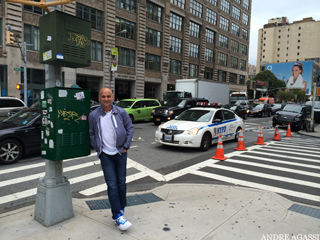
Early in Agassi's career, he remembers displaying some immaturities and close-mindedness at the U.S. Open. He did not embrace the situation surrounding his side of the net. He credits the crowd for pushing him to change.
"You know why they're there. You know why you're there," Agassi says. "Delivering for them, they just made me feel so rewarded for delivering a memory to them. That's how New Yorkers are. If you're not going to give us a memory, then we're going to give you a memory. I spent a few years with them dropping that on me. Shame on you for not bringing out your best, so we're going to treat you how you deserve. As a result they not only watched me grow up, but they helped me grow.
"That's what I mean when I say I miss New York, I miss being out there, I miss the people. It's a platform. That platform was treasured."
Agassi won his two U.S. Opens in 1994 and 1999. He also appeared in the final in 1990, 1995, 2002 and 2005. Times have changed since Agassi's heyday though. The U.S. Open features blue and green courts rather than solid green. Court 17 has become a fourth "show court" and attendance is even greater. Instant replay is embedded in U.S. Open culture and equipment technology has changed.
Agassi insists it is hard for him to make judgments on the differences in the contest.
"I used to see it from only one perspective and now I see it from only one perspective, but it's a different perspective. I was never a fan before and I'm not a player now," he says.
However, there is one modern alteration Agassi cannot help but reimagine had it been a part of his U.S. Open career. After a series of rainy years forced the men's Sunday final to be moved to Monday -- after the Saturday semifinals -- the USTA opted to build a third Monday into the U.S. Open schedule for the official men's final scheduled date. This adds an extra day of rest before the final -- something Agassi did not have during his sixth final appearances.
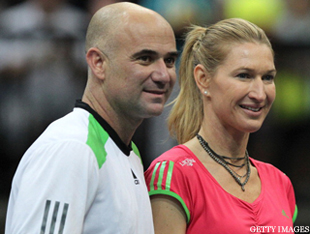
"I can only imagine what that must feel like," Agassi says. "I know how many years I wish I had that. It changes. It puts an asterisk next to every accomplishment prior to it because so many champions would be different if there was that extra 24 hours. Everybody struggles with change, but change happens and it is what it is. A little something special was lost in giving that up, but I think you also gain a quality of performance for the finals, which brings about its own good things."
As for predicting winners this, factoring in rest, Agassi is remaining conservative with former champions Novak Djokovic and Serena Williams.
"It's hard to always not pick Serena because when she's in full flight, it just seems like she's a level above," Agassi says. "I won't stand alone in that call of the women's side.
"When I look at that draw, Djokovic, although he hasn't had the greatest summer, with the draw he has, few rounds under his belt, he'll find his form. I think Feds (Roger Federer) will probably cruise through to the finals. Djokovic, my guess, would be put an end to it there," Agassi says of the men's draw.
As for his New York appearance in Duarte Square, Agassi was one of a number of players, including Williams, to play on the temporary Nike Court set up in TriBeCa. Agassi was sponsored by Nike from 1988 to 2005, but left the company for Adidas in 2005. Agassi returned to Nike in 2013 for both nostalgic and charitable reasons.
He refers to his return to Nike as "coming back home." Agassi is quick to mention the setup in Duarte Square is reminiscent of a Nike commercial he did with Pete Sampras back in 1995. The ad was symbolic of Agassi and Sampras' mark on tennis fans.
"It brings back memories of me and Pete in the streets of San Francisco even though people thought it was New York," Agassi says. "Stopping traffic, doing the commercials. They motivated people to get out there, get active and engaged."
Agassi rallied with two local children on the Nike Court in front of the crowd -- a couple hundred more than the kids usually experience, but a couple ten-thousand less than he saw at Arthur Ashe Stadium. The event helped promote the Nike Court line of shoes and apparel and Designed to Move, an initiative encouraging childhood exercise.
Agassi and Nike also support the Andre Agassi Foundation For Education. In 2001, Agassi opened the Andre Agassi College Preparatory School in Las Vegas, which saw its first graduating class come through in 2009. Through the Turner-Agassi Charter School fund, 39 total schools have sprouted up with Agassi's help in the last decade-plus. The latest school, the Metropolitan Lighthouse Charter School, opens this August in the Bronx, N.Y., with 322 students grades K-6 (588 students K-12 at maturation).
-- Follow Jeffrey Eisenband on Twitter @JeffEisenband.











